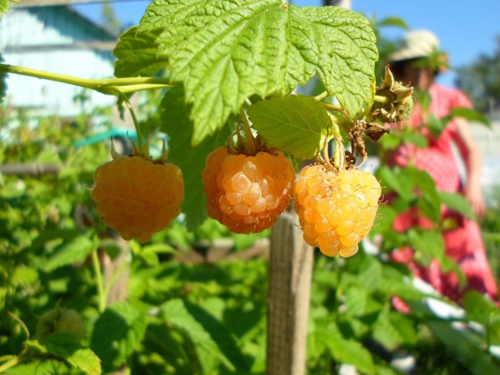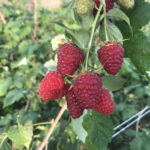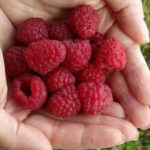Raspberry variety Golden domes
The repairing raspberry called Golden Domes is a wonderful variety of breeding by domestic scientists from the All-Russian Institute of Selection and Technology of Horticulture and Nursery. It was withdrawn at the Kokinsky strong point of VSTISP located in the Bryansk region by a team of authors consisting of V.L. Kulagina, S.N. Evdokimenko, under the leadership of the famous specialist in this culture, academician of the Russian Academy of Agricultural Sciences, Honored Scientist of the Russian Federation I.V. Kazakov.
Ivan Vasilyevich devoted his whole life to raspberries, and his remontant varieties became a world-class achievement, spreading in various countries and regions. He managed to ensure that the new forms had a short growing season with a modest sum of active temperatures, managing to give up a significant part of their potential harvest in the middle zone of our country before the onset of frost. In addition, the main criteria for the selection of hybrid offspring necessarily became high gastronomic and aesthetic qualities of fruits, increased resistance to pests and diseases, general unpretentiousness in cultivation and, of course, decent yield.

All these qualities are fully possessed by our heroine. It is distinguished by a rather large berry, good productivity, high economic characteristics, dessert taste and versatility of harvest use. All this made this raspberry popular among amateur gardeners, and also opened up prospects for its industrial cultivation. No wonder the variety passed a strict state variety test, and according to its results, in 2005, it was officially included in the State Register of Breeding Achievements of the Russian Federation and recommended for cultivation in the regions of the Central Non-Black Earth Region.
Agrobiological characteristics of the variety
Plants have an average vigor of growth, reaching a height of 1.3-1.5 meters. The tops of thin shoots drooping, which is why the bushes of the Golden Domes have a spreading appearance, require the arrangement of supports and subsequent garters. It is especially convenient to tie up annual stems on one side of the trellis, and biennial ones on the other. This will greatly facilitate the care, harvesting and removal of fertile parts of the plant. The growth activity of replacement shoots is average, about 5-6 pieces grow annually. The stems are highly branched, the internodes are moderately long. The shoots of the current year are colored light green, covered along the entire length with a waxy bloom, light pubescence and spines of medium size and density. In the second year, the color changes to light brown. The fruiting zone of raspberries begins at a distance of 50-60 cm from the ground, and, thus, more than half of the length of the shoots is fruitful. Leaves are compound, consist of three or five wrinkled, slightly pubescent green leaves, often curling downward. Their shape is oval with a pointed end. Veins are light green, well-defined, petioles are short and medium, without signs of anthocyanin pigmentation. The edges of the leaf blade are indented with small saw-like denticles. Branching laterals grow from each axil of leaves, on which 5-8 ovaries are compactly located. The growth activity is weak, and therefore the site is easy to maintain in a clean state, but during reproduction, a certain deficiency of planting material may occur.

Golden domes are a self-fertile variety, which allows you to get a guaranteed harvest regardless of weather conditions during the flowering period and the activity of the flight of pollinating insects. Flowers on last year's shoots usually appear in May, and on those growing in the current season - in early July. Fruiting takes place accordingly, starting in June and early August, respectively.At the same time, many lovers of remontant raspberries refuse to obtain two harvests, arguing that after the first fruiting, the bushes weaken, which is why they are not able to sufficiently realize the potential of the remontant variety. With the annual autumn mowing of all stems, young shoots for the next year grow more actively, enter fruiting earlier and manage to give a larger harvest before frost. This is especially true for the northern regions with a short frost-free period.
The peduncle of the variety is short, during harvesting it separates well from the berries, but at the same time it can keep overripe raspberries from shedding for a long time. The total yield of the variety is above average. From a bush per season, you can get 1.7-2 kg of fruits, and from a hectare of plantings in an industrial planting - up to 100-120 centners. Even if these are not the most outstanding indicators among modern varieties, the originality of the form for many gardeners compensates to some extent for the disadvantages of its productivity. In the middle zone of the country, before the onset of autumn frosts, the Golden Domes realize their yield potential by 70-90%. In more southern regions with a long growing season, this figure can reach 100%.
Ripe berries are rather large, with an average weight of 3.5-4 grams, the most outstanding fruits can reach 6 grams. Their shape is hemispherical, the surface is slightly pubescent. Typical color is golden yellow, but apricot tones begin to appear when harvesting is delayed. The consistency of the pulp is delicate, very juicy with a pleasant sweet and sour taste and a typical raspberry aroma of medium intensity. The content of dry matter in fruits is 13-14%. Sugar accumulation is quite high - 6-7% with a titratable acidity of about 1.5%. At the same time, ascorbic acid, better known as vitamin C, contains 17-18 mg per 100 grams of raspberries. The variety is quite light-loving, and with a lack of sunlight, especially in rainy summer, there is a deterioration in the biochemical composition of the fruits, and the berries themselves acquire an inexpressive watery taste. Under favorable cultivation conditions, the tasting characteristics of the variety are quite high.

The direction of application of the harvested harvest of Golden Domes is universal. This raspberry can be successfully consumed fresh and used for home preservation. Among consumers, it is popular for its beautiful unusual color, but its cultivation in large volumes on farms is limited by the not too high transportability of the fruits. Only berries collected in small containers are able to enter the market, keeping their presentation sufficiently. The surplus of the harvest obtained on the backyard and garden plots, their owners are successfully used in the preparation of various preparations for the winter - compotes, preserves, jam, confiture. All these products are distinguished by their excellent taste, as well as high content of vitamins and minerals, making them excellent for replenishing their deficiency in the human body during the cold season.
From an economic point of view, our heroine can only be praised for her unpretentious care and good resistance to unfavorable environmental factors. The variety has not been found to have a predisposition to a certain type of soil, and even in non-chernozem conditions it grows well, demonstrating its standard yield. Only excessive acidity or salinity of the soil can limit the possibility of using the site for cultivation. The variety is able to withstand short summer droughts. When one harvest per season is obtained and all shoots are removed in the fall, the frost resistance of the bushes covered with snow becomes truly limitless.The Golden Domes are also highly resistant to major diseases and pests of crops, which allows only preventive treatments of bushes with chemical plant protection agents, obtaining an environmentally friendly harvest.
Agrotechnical features
For raspberries, areas with a flat profile or a slight gentle slope are chosen. The terrain must provide good wind protection so that snow does not blow off the raspberry tree in winter, since in this case the risk of freezing of bushes and even their death in frost-prone regions sharply increases. The direction of the slope can vary depending on the humidity of the climate. In the south, they usually choose cool expositions, and in the north, on the contrary, warm ones. Lowlands and closed hollows are not used for planting, where there is stagnation of cold air, and often excessive dampness of the soil.
In one place, raspberries can grow, giving high yields, for 7-10 years, after which it is recommended to stubble. It will be possible to return the culture here no earlier than in 5-6 years. Planting of the variety is carried out in early spring or autumn after leaf fall. Beforehand, the soil must be prepared, on which the presence of perennial weeds is not allowed, and planting holes, abundantly filled with mineral and organic fertilizers, must be dug. Having covered the seedlings with earth, they are cut off at a height of 30 cm and watered well.
The row spacings of fruiting raspberries are kept free from weeds and root suckers. If necessary, the plantation is watered. The shoots of the Golden Domes are tied to a trellis. In the case of the classic two-year cultivation option, after fruiting, last year's parts of the bush are removed. According to the one-year remontant scheme, all shoots are cut out at ground level after the first autumn frosts. The cut stems are burned, due to which most of the pests and pathogens die, and the phytosanitary state of the plantation is significantly improved.








